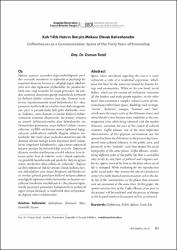Kırk Yıllık Hatırın İletişim Mekanı Olarak Kahvehaneler
Özet
Mekan, yaşanışı açısından değerlendirildiğinde yerelden evrensele insanların ve toplumların paylaştığı bir yaşamsal deneyim tarzına ev sahipliği yapar. Medeniyetin özü olan toplumsal alışkanlıklar bir yandan her türlü sınırı aşıp insanları bir araya getirirken, öte yandan yaşamsal deneyimin geçtiği mekanlarda karmaşık bir kültürel ilişkiler sistemini inşa eder. Osmanlı kentlerinin biçimlenmesinde temel bölümlerden biri olan, günümüz kentlerinde ise sınırları biraz daha kayganlaşan, çarşı ve çarşıyla özdeş hale gelen dükkanlar, arasta, bedesten, cami, hamam ve hanlar kültürel ilişkiler sisteminin zeminini oluştururlar. Bu fiziksel ortamın en önemli belirleyicilerinden olan kahvehaneler ise, Osmanlı’dan günümüze, sosyo-kültürel ilişkileri kamu sahasına, özellikle söz konusu alanın toplumsal topografyasını şekillendiren mahalle ölçeğine aktaran mekanlardır. Her türlü siyasi ya da dini otoritenin çok sıkı denetim altında tuttuğu kamu hayatının farklı kutuplarını simgeleyen kahvehaneler, çoğu zaman toplumsal hayatın yeniden biçimlendirildiği yerlerdir. Toplumsal düzenin yeniden üretilmesine aracılık ederken, hem tükenen yerler, hem de tüketim yerleri olarak toplumların gündelik hayatlarında çok yönlü bir iletişim ağının üretici merkezleri olma rolünü de üstlenirler. Özgürce seçilmiş toplumsal ilişkiler ortamı olarak kullanıcılarının dokudukları yeni hayat felsefesini şekillendirirler ve sınırları giderek genişleyen kültürel dolaşım şebekesi aracılığıyla toplumun bütün katmanlarını kuşatan sosyalleşme hareketine öncülük ederler. Bu çalışma kapsamında geçmişten günümüze kahvehanelerin mekansal yapısı ortaya konacak ve modernlik ötesi tartışmalarda değişim süreci irdelenecektir. Space, when considered regarding the way it is used, represents a style of a residential experience, which, from the local to the universal shared by human beings and communities. While on the one hand, social habits, which are the essence of civilization, overcome all the borders and make people together, on the other hand, they constitute a complex cultural system of relations faced within those spaces. Buildings such as shops, “arasta”, “bedesten”, mosque, “hamam” and “han,” which were the major units of the Ottoman towns and whose borders have become more indefinite in the contemporary cities while being identical with the market (bazaar), constitute the base of this system of cultural relations. Coffee Houses, one of the most important characteristics of this physical environment, are the spaces that from the Ottomans to the present day transferred socio-cultural relations to the public area, and primarily to the “mahalle” scale that shaped the social topography of the same places. Coffee Houses, symbolizing different poles of the public life that is controlled very firmly by any form of political and religious authority, appear most of the time as the place where social life is reshaped. While mediating for the reproduction of the social order, they assume the role of a productive center of a multi-faceted communication web in the daily life of the communities, as the places that consume and are consumed at the same time. In this paper, the spatial construction of the Coffee Houses from past to the present will be analyzed, and the process of change in the beyond-modern discussions will be scrutinized.
Kaynak
Anadolu Üniversitesi Sosyal Bilimler DergisiBağlantı
https://hdl.handle.net/11421/1650Koleksiyonlar
- Cilt.14 Sayı.3 [12]
- TR-Dizin İndeksli Yayınlar Koleksiyonu [3512]


















